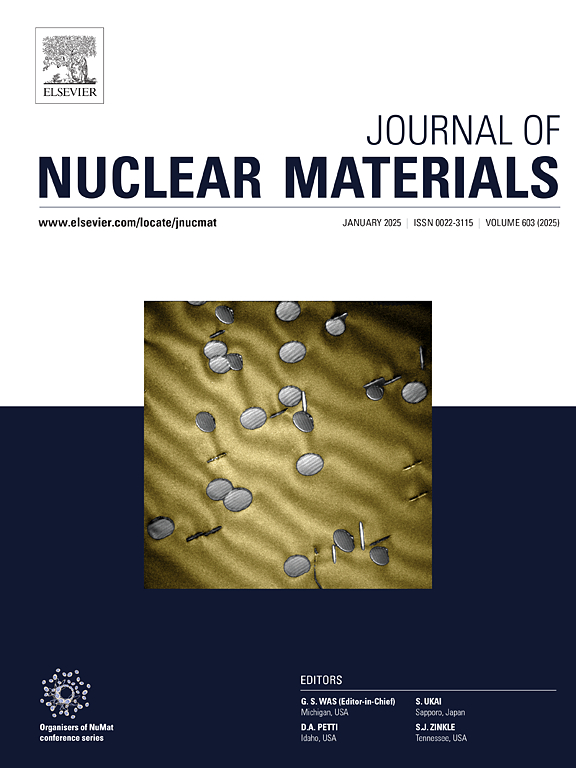Utilizing a machine-learned potential to explore enhanced radiation tolerance in the MoNbTaVW high-entropy alloy
IF 2.8
2区 工程技术
Q3 MATERIALS SCIENCE, MULTIDISCIPLINARY
引用次数: 0
Abstract
High-entropy alloys (HEAs) based on tungsten (W) have emerged as promising candidates for plasma-facing components in future fusion reactors, owing to their excellent irradiation resistance. To achieve physically realistic descriptions of primary radiation damage in such multi-component materials, we propose extended damage models and trained an efficient machine-learned interatomic potential for the MoNbTaVW quinary system. From cascade simulations at primary knock-on atom (PKA) energies of 1–150 keV, we fitted an extended arc-dpa model for quantifying radiation damage in MoNbTaVW. Furthermore, we performed 50 cascade simulations at the recoil energy of 150 keV with 27.648 million atoms to investigate the effect of PKA types (Mo, Nb, Ta, V, W). The results show that subcascade splitting effectively suppresses interstitial cluster formation, which is a key mechanism for enhancing radiation resistance in HEAs. Our findings provide valuable insights into the radiation resistance mechanisms in refractory body-centered cubic alloys and highlight the potential of machine learning approaches in radiation damage research.
利用机器学习潜力探索MoNbTaVW高熵合金的增强辐射耐受性
基于钨(W)的高熵合金(HEAs)由于其优异的耐辐照性能而成为未来聚变反应堆等离子体面组件的有希望的候选材料。为了在这种多组分材料中实现对初级辐射损伤的物理真实描述,我们提出了扩展的损伤模型,并为MoNbTaVW五元系统训练了有效的机器学习原子间势。在1-150 keV的一级碰撞原子(PKA)能量级联模拟中,我们拟合了一个扩展的弧-dpa模型来量化MoNbTaVW的辐射损伤。此外,我们用2764.8万个原子在150 keV的反冲能量下进行了50次级联模拟,以研究PKA类型(Mo, Nb, Ta, V, W)的影响。结果表明,亚级联分裂可有效抑制间隙团簇的形成,这是增强HEAs抗辐射能力的关键机制。我们的研究结果为耐火体心立方合金的耐辐射机制提供了有价值的见解,并突出了机器学习方法在辐射损伤研究中的潜力。
本文章由计算机程序翻译,如有差异,请以英文原文为准。
求助全文
约1分钟内获得全文
求助全文
来源期刊

Journal of Nuclear Materials
工程技术-材料科学:综合
CiteScore
5.70
自引率
25.80%
发文量
601
审稿时长
63 days
期刊介绍:
The Journal of Nuclear Materials publishes high quality papers in materials research for nuclear applications, primarily fission reactors, fusion reactors, and similar environments including radiation areas of charged particle accelerators. Both original research and critical review papers covering experimental, theoretical, and computational aspects of either fundamental or applied nature are welcome.
The breadth of the field is such that a wide range of processes and properties in the field of materials science and engineering is of interest to the readership, spanning atom-scale processes, microstructures, thermodynamics, mechanical properties, physical properties, and corrosion, for example.
Topics covered by JNM
Fission reactor materials, including fuels, cladding, core structures, pressure vessels, coolant interactions with materials, moderator and control components, fission product behavior.
Materials aspects of the entire fuel cycle.
Materials aspects of the actinides and their compounds.
Performance of nuclear waste materials; materials aspects of the immobilization of wastes.
Fusion reactor materials, including first walls, blankets, insulators and magnets.
Neutron and charged particle radiation effects in materials, including defects, transmutations, microstructures, phase changes and macroscopic properties.
Interaction of plasmas, ion beams, electron beams and electromagnetic radiation with materials relevant to nuclear systems.
 求助内容:
求助内容: 应助结果提醒方式:
应助结果提醒方式:


